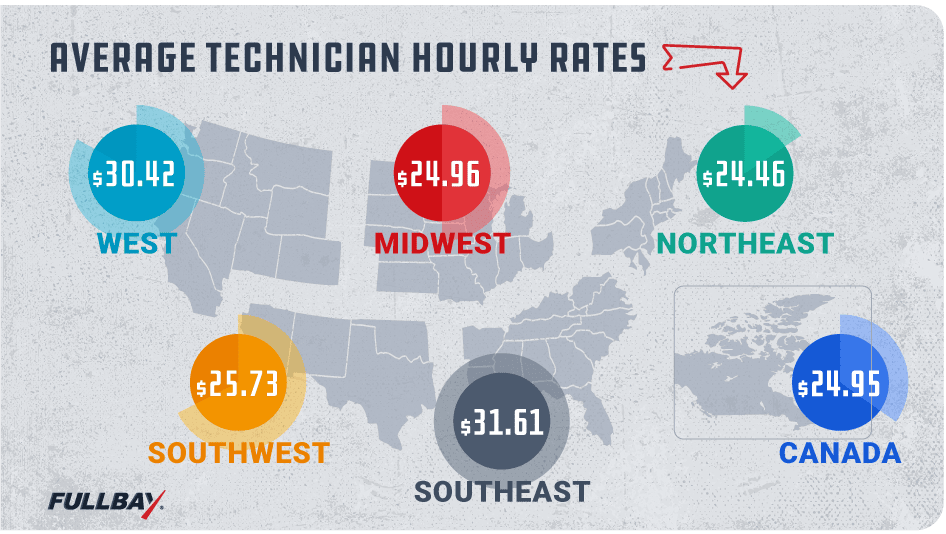How to Set A Technician’s Hourly Rate

“Money, money, money,” a wise band called ABBA once said, “must be funny.”
While we love the Swedish rockers as much as the next person, we have to admit they were wrong here. Money isn’t funny, especially when you need it…which is all the time.
This lead-in sort-of segues into our actual topic for this blog, which is what to pay your techs.

We don’t mean the labor rate—although labor rates and hourly rates are tied closely together—we mean your techs’ actual take-home pay. Their cut of the spoils, if you want to talk in pirate terms (and we do).
To help us with this article, we got on the phone with Andrew and Glen of Integrity Fleet Services in Washington. You may remember them from this previous awesome article about trailer repair. Along the way, we also heard from Fullbay Co-Founder and Executive Chairman Jacob Findlay; Fullbay COO Chris O’Brien; and Success Manager Russ Schwartzman.
(In other words, we talked to a lot of people!)
HOW DO YOU CHOOSE AN HOURLY RATE?
So, let’s get one thing out of the way. We can’t tell you “Pay your techs $XX an hour and you will receive eternal success and happiness.”
What you pay your techs—like what you charge your customers—is something of a judgment call, based on (hopefully) careful research and knowledge of both the industry and your local market.
Something to understand about the hourly rate is that it isn’t a standalone expense. It’s generally the backbone of your labor rate, or what you charge your customers for an hour of your techs’ work. Data from our State of Heavy-Duty Report indicates that—depending on where you are—your hourly rate makes up about 22% to 30% of your labor rate. In some cases, it’s a little more or a little less.
BEHOLD THIS EXCELLENT CHART

The report also has some information around hourly rates in specific regions. For example, techs in the Southeast make an average hourly wage of $31.61, while in the Northeast they’re making $24.46. Yes, there’s more work to do to sort out what your proper wage should be—the Southeast region comprises a lot of territory—but the report is a good starting point.
OK, so you can generally see what some other techs in your area are being paid…but what else can you do?
The people we spoke to were split on further research. We’ll break it down a little:
- “Mystery calling,” or asking what other shops might charge for a two- or three-hour job and boiling down a potential hourly wage from that ballpark figure.
- Straight up asking what they pay.
- Asking techs you’re interviewing what they expect to make (you should do this anyway).
The first two points are often dependent on comfort level. Some shop owners aren’t keen on calling around asking for rates. Others have no problem with it. Figure out where you fit in.
STATE-BASED SITUATIONS
Someone once said, “California is insane about pay.”
This is relevant to our discussion.
If a technician is waiting around for a job, or for parts, they receive an additional rate on top of their hourly wage. And if a technician brings their own tools to a job, you have to pay them double minimum wage (which in California is $15).
(Want to learn more about California’s mechanic-centric rules? Head over here.)
While most other states aren’t going to be quite as…erm…stringent about pay types, this is a good example of something you’ll need to factor into your initial research and calculations.
DECIDING ON THE HOURLY RATE
The discussion starts early for Andrew and Glen, who usually bring it up during the interview process. “We want to make sure they’re going to make what they need to live on,” Andrew says, noting that if Integrity isn’t paying a tech enough, “they’re always going to have their eye on another job that’s going to pay them more.”
So, Integrity’s starting point is typically to offer a tech at least what they make at their current job—if not more. At this point, they also fold a new tech into the operation’s existing payscale—paying X for a certain skill level.
“We’re not trying to get bargains,” Glen adds. “We want to find the most experienced people we can, who fit our culture—but if we have to step up to get the right person, it’s better to do that than play coy. At the end of the day, they have to go home and pay bills and take care of their families.”
That echoes a sentiment we’ve heard across the industry—cheap work is something of a race to the bottom.
BENEFITS, ETC
There’s no two ways about it: Benefits are expensive.
When Integrity was just getting started, they took a look around at what other shops were offering. Most of their immediate competitors were small and independent; very few, if any, offered any kind of benefits package.
Andrew and Glen saw a spot where Integrity Fleet Services could stand out. Yes, it was pricey, but offering a full benefits package right from the start elevated them in the eyes of techs looking for work. Other shops eventually caught on, and benefits became…well, if not standard, then at least more commonplace. Because Integrity had offered them from the start, though, they didn’t have to figure out how to carve room for them in the budget.
RAISES & THEIR IMPACT ON YOUR LABOR RATE
So, let’s talk raises. You know, those annual (hopefully) salary increases that keep people happy.
Here’s where things can get a little hairy.
You’ve got to give raises. The cost of living goes up every year even without inflation piling on expenses. Andrew and Glen, after keeping an eye on the market and rising prices, opted to get ahead of things by giving raises at the beginning of 2022—their techs received about an 11% bump.
But that 11% has to come from somewhere. Usually, it’s the labor rate. So let’s talk about that.
Integrity reviews their labor rate every quarter, “if not monthly,” Andrew says. And when you raise the hourly wage for your techs, you’ve got to bake that raise into your labor rates. (That’s a whole other article series—start here and keep reading here!)
Russ had something to add to that: in the diesel industry, things will often remain…well…in one place because “that’s how we’ve always done it.” He discussed an operation that hadn’t raised their rate in years, and finally implemented a hefty increase quite recently. “But if you haven’t raised your rate in five years, you’ve thrown a lot of money out the door.”
There’s another drawback to infrequent but high labor rate increases: your customers may not be able to sustain it. Smaller, semi-frequent increases are part of the course of doing business. No one will bat an eye at a $5 or even $10 increase. But $30, $40, $50 at a time?
Yeah, that’s a hard impact.
WHAT ELSE CAN YOU OFFER?
Money is important. At the end of the day, your techs care about whether they can pay their bills and, you know, stay alive. With that said, money isn’t the only thing.
Here are a few other ways to make your shop extra appealing to techs:
- Benefits packages: We talk a bit about this above, but a comprehensive benefits plan, PTO, etc., should absolutely be part of any offer.
- Food & beverages: OK, they’re absolutely not a replacement for an adequate wage, but providing, say, delicious snacks and good coffee (among other things) are an excellent way to show your staff you appreciate them.
- Flexible hours: Flex hours aren’t just for Silicon Valley anymore! Yes, creating flex schedules requires some extra footwork (this is a service job—you do need people in the bay), but they can help you attract and retain talent.
- Career pathing & development: If techs have a way to get promotions, extra training, and certifications, they become more valuable—and often happier.
- Bonus structures: Bonuses aren’t limited to the holidays—you can give your techs some extra cheddar for efficiency, for meeting and exceeding KPIs, and all sorts of other things. (Please note, while we love cheese, in this case cheddar means money…however if you want to offer a tech some actual cheddar along with their monetary bonus, more power to you.)
All of the above are important aspects of a work environment, especially a high-stakes one like a commercial repair shop. But everything—everything—boils down to that hourly wage. Get that right and you can build a successful operation that you can grow over time. Get it wrong, and, well, your techs will be leaving you for higher-paying jobs pretty fast.
A solid hourly wage is your bedrock. As long as you keep that in mind, the sky’s the limit!

